Cedar Point – Sandusky, Ohio
If you’re a coaster and you’re located at a park that has sixteen other coasters besides yourself competing for the guest’s attention, it can be relatively easy to become overlooked. Cedar Point’s coaster collections can more or less be divided into one of two groups: first, the elite group of newer headlining attractions that can generate hour long waits and frequently find rankings in numerous coaster polls, coasters that are not simply ‘rides’ but rather an ‘experience’. These are Millennium Force, Maverick, Top Thrill Dragster, Raptor and Magnum. Then there are the rest of the older, smaller-scale coasters that are there either to allow younger riders a way to work themselves up to the big ones (Iron Dragon, Cedar Creek Mine Ride, Disaster Transport), or are there primarily for fun and to fill in the gaps between the starring attractions (Gemini, Blue Streak, Wildcat), if they’re not just outright bad (Corkscrew, Mean Streak).
Where do Wicked Twister and Mantis fit in? They’re certainly built like they’re starring attractions; Mantis clearly intended to be a larger, stand-up counterpart to the much-loved inverted Raptor, while Wicked Twister is a one-of-a-kind display of innovative technology and ideas that manages both some pretty extreme sensations while also being the third tallest and fastest roller coaster on the Point’s peninsula.1 But they’re not. Mantis is frequently mentioned in the same contemptible breath as Mean Streak due to frequent roughness in the awkward stand-up cars, and while Wicked Twister has a small following that might think it’s one of the best three or even two coasters in the park, it’s hard not to view it as more of an extreme flat ride rather than fully fleshed-out roller coaster experience. Both are easily overlooked or dismissed as gimmicky, but could there be more than meets the eye?
Wicked Twister
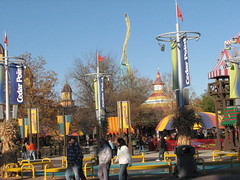 Chalk it up to the beachfront location or the way it perfectly frames the Giant Wheel, but Wicked Twister just seems like a natural fit for the park. Unlike other Intamin impulse coasters where the towers can be a bit of an eyesore from the main midways, Wicked Twister’s bold sunburst yellow spiral towers contrast sharply against the blue sky and lake but don’t detract from the rest of the surroundings. It also serves that area of the park well, as before 2002 the Oceana Midway as it was called was just sort of dead and outdated looking, but with the addition of Maxair and the rest of the renovations in 2005, this corner of the park is now quite colorful and flowing with enough positive energy that we can overlook the fact that it’s also home to Disaster Transport.
Chalk it up to the beachfront location or the way it perfectly frames the Giant Wheel, but Wicked Twister just seems like a natural fit for the park. Unlike other Intamin impulse coasters where the towers can be a bit of an eyesore from the main midways, Wicked Twister’s bold sunburst yellow spiral towers contrast sharply against the blue sky and lake but don’t detract from the rest of the surroundings. It also serves that area of the park well, as before 2002 the Oceana Midway as it was called was just sort of dead and outdated looking, but with the addition of Maxair and the rest of the renovations in 2005, this corner of the park is now quite colorful and flowing with enough positive energy that we can overlook the fact that it’s also home to Disaster Transport.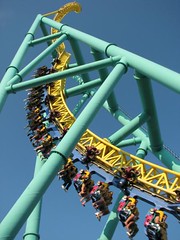
But as for the ride itself, is it really that great as a coaster? It goes back and forth several times along a short stretch of track shaped in a large U while spinning the riders. That sounds less like a coaster than like an oversized Disk’ò. Obviously the ride system itself qualifies as a coaster, it’s all the same technology and interface as any other inverted shuttle coaster, but the fundamental nature of the attraction seems to recall less that of a roller coaster— which normally implies some sort of layout with pacing that progresses through a complete experience— than a flat ride, which are only about repetitive motions designed to create and then sustain a singular form of sensation. While it fully qualifies as a coaster, it doesn’t deserve an analysis that extends any further than that which would be befitting of a flat ride. In short, the rotation and freefall up the spikes can be fun, especially if you’re in the back on the second trip up the rear spike, and it has some good speed and strong forces on either end of the pullout once the cycle reaches full speed. That’s all that needs to be said about Wicked Twister, moving on…
Mantis
I still approach Mantis with apprehension. It’s generally not a coaster I go out of my way to ride, but if I’m passing by it on my way to or from Millennium Force and I look up at its dominating vertical loop and first drop and the crowds aren’t too bad, I really don’t have a good reason to pass it by. Some people would say that there are plenty of good reasons to just keep walking, such as a general interest in self-preservation. Yes, the general consensus seems to be that Mantis is a very unpleasant experience and is one of the two or three coasters located on Cedar Point that should be actively avoided at all costs. Considering that Mantis was created by one of the most popular and beloved design firms of all time and located at one of the most popular and beloved parks of all time, one has to wonder how seriously messed-up Mantis must be to have earned it such a reputation.
For starters, the capacity doesn’t do the coasters any favors.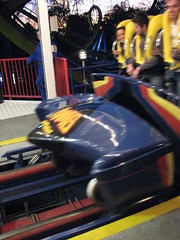 Back in the day it would routinely see some of the longest waits in the park, outdone only by Millennium Force and Top Thrill Dragster at the prime of their popularities. It was designed to run three trains in theory, but they quickly realized that trying to get everyone on the loading platform to stand up straight at the same time so they could lock the seat height takes a fair number of practices before they can get it right, so they’re permanently down to two trains with the third one shrink-wrapped in blue plastic sitting under the transfer track shed, presumably being used as a parts donor for the other two trains. After waiting in a slow-moving line for multiple hours in a queue on a hot concrete pad watching trains cycle only once every couple minutes, when people finally get their turn to ride and find out that all of that was for an experience of considerably lower quality than MF or TTD, it’s not hard to see why Mantis is disadvantaged from the start.
Back in the day it would routinely see some of the longest waits in the park, outdone only by Millennium Force and Top Thrill Dragster at the prime of their popularities. It was designed to run three trains in theory, but they quickly realized that trying to get everyone on the loading platform to stand up straight at the same time so they could lock the seat height takes a fair number of practices before they can get it right, so they’re permanently down to two trains with the third one shrink-wrapped in blue plastic sitting under the transfer track shed, presumably being used as a parts donor for the other two trains. After waiting in a slow-moving line for multiple hours in a queue on a hot concrete pad watching trains cycle only once every couple minutes, when people finally get their turn to ride and find out that all of that was for an experience of considerably lower quality than MF or TTD, it’s not hard to see why Mantis is disadvantaged from the start.
Contributing most dramatically to that perception that the coaster is of inferior quality is the roughness. For whatever reason, stand-up trains do not seem to track as well as other B&M rides. Perhaps it’s from the excessively heavy trains and the fact that rider’s heads are so much farther above the rails than on other car designs, small vibrations become multiplied by the extra mass and then made worse by the farther distance they have to travel up the back columns. Or maybe the wheel assemblies just don’t hug the rails that tightly, or the wheels become more easily deformed due to the extra weight. I don’t know; all I do know is that I’ve had rides on it where I’ve seriously had to question the existentialist assertion that a state of existence, even if it is in pain and without meaning, is better than a state of non-existence. The most recent
do not seem to track as well as other B&M rides. Perhaps it’s from the excessively heavy trains and the fact that rider’s heads are so much farther above the rails than on other car designs, small vibrations become multiplied by the extra mass and then made worse by the farther distance they have to travel up the back columns. Or maybe the wheel assemblies just don’t hug the rails that tightly, or the wheels become more easily deformed due to the extra weight. I don’t know; all I do know is that I’ve had rides on it where I’ve seriously had to question the existentialist assertion that a state of existence, even if it is in pain and without meaning, is better than a state of non-existence. The most recent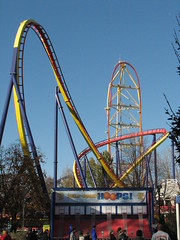 of those rides was over five years ago.
of those rides was over five years ago.
Maybe it’s just good luck on my part but every ride I’ve had on Mantis since (if my memory serves me correctly) at least 2006 has performed somewhere on a spectrum spanning from slightly bumpy but completely tolerable if you know what’s coming next, to as smooth as your average B&M sitdown looping coaster (read, still not glass smooth, but that myth I’ll feel like dispelling another time). Granted, I’ve only ever been on it during early season weekdays or on Halloweekend Friday and Sundays when the park isn’t as crowded so it’s possible I might have some sort of sampling error in terms of the rides I’ve had on it, but honestly based on some of the better Mantis rides I’ve had in recent years I could probably call it one of my favorite coasters in the park if I could ever get over myself.
As I am frequently apt to complain in reviews of B&M’s rides, their layouts normally consist of nothing but plugging one huge, generic element in after another, and they’re unable to maintain good dramatic tension, the second half always being lesser in nearly all regards compared to the first, with riders normally having already checked out in the final moments of the ride and just waiting for the brakes to come. In my eyes at least, Mantis avoids both these pitfalls, making it one of an extreme few of B&M’s creations to do so.
the second half always being lesser in nearly all regards compared to the first, with riders normally having already checked out in the final moments of the ride and just waiting for the brakes to come. In my eyes at least, Mantis avoids both these pitfalls, making it one of an extreme few of B&M’s creations to do so.
 In terms of actual elements featured on Mantis, despite only featuring four inversions, there’s a surprisingly good variety of maneuvers to be found, and even one of those inversions is relatively unique by B&M’s standards (Mantis’ original inclined loop was only reproduced twice in later B&M designs). I will forgo giving a play-by-play analysis of the first half since it’s basically identical to what I wrote for Six Flags Kentucky Kingdom’s now-vanquished Chang, and will just highlight the few points that I see to
In terms of actual elements featured on Mantis, despite only featuring four inversions, there’s a surprisingly good variety of maneuvers to be found, and even one of those inversions is relatively unique by B&M’s standards (Mantis’ original inclined loop was only reproduced twice in later B&M designs). I will forgo giving a play-by-play analysis of the first half since it’s basically identical to what I wrote for Six Flags Kentucky Kingdom’s now-vanquished Chang, and will just highlight the few points that I see to 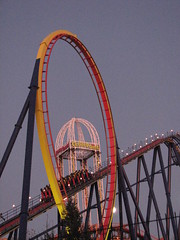 being key to the layouts’ success.
being key to the layouts’ success.
The opening section with the elevated curve, straight drop, and first two impressively oversized vertical loops is probably the most generic but it only constitutes roughly one-third of the overall ride and serves a very clear purpose as an opening act: WOW! Huge sense of scale, speed, hangtime at the top, overall very impressive and just a little bit intimidating without ever needing to be intense or fast-paced. Even people that get the ride when it’s running at the bottom of its form will generally find some pleasures in this section.
The next section is very original (at least relative to a B&M design), being based much more on twists, turns and slightly odd track geometry and features more varied pacing. After the cloverleaf turnaround over the station which itself has some nice little banking changes, the inclined loop over the lagoon stands as one of my favorite singular inversions on a B&M ride.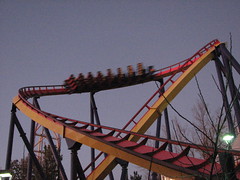 For the most part you get the same dynamics as on a vertical loop that produce that satisfying feeling of being flipped completely upsidedown (any sort of horizontal rolling motion as found on most other types of inversions will decrease this sensation). However, the trick to it is not just that the loop is leaning to the left by several degrees, but in that physically you cannot simply tip a regular vertical loop like that without incurring lateral g-forces
For the most part you get the same dynamics as on a vertical loop that produce that satisfying feeling of being flipped completely upsidedown (any sort of horizontal rolling motion as found on most other types of inversions will decrease this sensation). However, the trick to it is not just that the loop is leaning to the left by several degrees, but in that physically you cannot simply tip a regular vertical loop like that without incurring lateral g-forces to some extent, particularly at the bottom. Since that’s a big no-no for B&M, what happens is there’s a back-and-forth banking motion going up and down the loop that tries to neutralize any would-be lateral forces. This doesn’t detract from that ‘over and around’ looping motion but does make it feel much more interesting. After this inversion, instead of popping straight back up it continues with some non-standard pacing with the ground level s-curve that both sustained the speed for several moments, offers a quick moment of intensity in the fast direction change that hints at the final section of the ride to come, while even providing a quick pop of airtime that both pleases and surprises. A quick upward helix with a fast transition back to level at the top and the ride slides through the midcourse brake run… falling off it, if you’re in the back rows you can expect to get another strong boost of negative-g’s, assuming the brakes weren’t on too hard.
to some extent, particularly at the bottom. Since that’s a big no-no for B&M, what happens is there’s a back-and-forth banking motion going up and down the loop that tries to neutralize any would-be lateral forces. This doesn’t detract from that ‘over and around’ looping motion but does make it feel much more interesting. After this inversion, instead of popping straight back up it continues with some non-standard pacing with the ground level s-curve that both sustained the speed for several moments, offers a quick moment of intensity in the fast direction change that hints at the final section of the ride to come, while even providing a quick pop of airtime that both pleases and surprises. A quick upward helix with a fast transition back to level at the top and the ride slides through the midcourse brake run… falling off it, if you’re in the back rows you can expect to get another strong boost of negative-g’s, assuming the brakes weren’t on too hard.
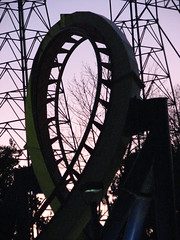 The final section is what I think makes Mantis the superior ride compared to the two other mega stand-up coasters that followed in its footsteps. Despite only having one corkscrew immediately after the midcourse brake, the rest of the ride is a nonstop collection of very intricate turns with sudden banking transitions, and the ride seems to add layer on top of layer of new direction changes that keeps the timing between elements and through transitions very fast all the way to the final brakes. Both Chang and Riddler’s Revenge sort of commit to the same sin we’ve seen on nearly every other B&M ride, sort of meandering around through some indeterminate twists and curves,
The final section is what I think makes Mantis the superior ride compared to the two other mega stand-up coasters that followed in its footsteps. Despite only having one corkscrew immediately after the midcourse brake, the rest of the ride is a nonstop collection of very intricate turns with sudden banking transitions, and the ride seems to add layer on top of layer of new direction changes that keeps the timing between elements and through transitions very fast all the way to the final brakes. Both Chang and Riddler’s Revenge sort of commit to the same sin we’ve seen on nearly every other B&M ride, sort of meandering around through some indeterminate twists and curves, eventually working up the momentum to do a complete inversion but sort of not taking the finale anywhere. Mantis’ finale, when running at a good pace (from reduced trims on the midcourse, a good greasing that morning or just favorable weather conditions) can be absolutely explosive, the highly-banked, tight turns switching directions on a dime several times within seconds of each other while snaking around close to the ground is quite a dynamic contrast between the opening section of the ride with the impressive but slowly-timed loops. And for the most part this pace doesn’t let up until it hits the brakes, finishing the ride with one last quick s-turn before the final transition snaps everyone back upright as they prepare for the final stop. I do wish it didn’t have to be over an empty gravel patch (look at how naturalistic Iron Wolf is, it’s about as compact as Mantis and it’s practically in the middle of the woods)
eventually working up the momentum to do a complete inversion but sort of not taking the finale anywhere. Mantis’ finale, when running at a good pace (from reduced trims on the midcourse, a good greasing that morning or just favorable weather conditions) can be absolutely explosive, the highly-banked, tight turns switching directions on a dime several times within seconds of each other while snaking around close to the ground is quite a dynamic contrast between the opening section of the ride with the impressive but slowly-timed loops. And for the most part this pace doesn’t let up until it hits the brakes, finishing the ride with one last quick s-turn before the final transition snaps everyone back upright as they prepare for the final stop. I do wish it didn’t have to be over an empty gravel patch (look at how naturalistic Iron Wolf is, it’s about as compact as Mantis and it’s practically in the middle of the woods)
 I have a feeling that it’s been dreamt by many other Cedar Point fans that the ride one day get its stand-up cars replaced with sitdown or even floorless cars. I wouldn’t be opposed to such a move, if only for reasons that it would undoubtedly increase the capacity which is still sorely lacking on busy days. That said, I do have a bit of an affinity for the stand-up car design, at least whenever it’s also not the direct cause of severe jostling. The body’s in a much more vulnerable position to forces, the small pops of air found along the course or hangtime in the first loop are much scarier than if experienced with other seating designs. Also as a result of the standing position, one is able to sense rotational forces much more strongly (especially horizontally in fast transitions and forward/backward over drops and loops) and consequently the movement through space feels much more imminent. Besides, it is undeniably a different sort of experience to go through a ride standing up, and after riding every other coaster in the same position, Mantis sees the removal of that comfort zone. While it’s still probably a ride to be avoided on busy days when there are better uses of one’s time, on days when crowds are light and the train isn’t beating its rider’s up, Mantis is probably one of the park’s better roller coasters. One final comment: want to know why they call it Mantis? Well, besides the whole “they looked up the definition of Banshee in the dictionary” thing, look at the ride from Millennium Force’s queue area and tell me what you see…
I have a feeling that it’s been dreamt by many other Cedar Point fans that the ride one day get its stand-up cars replaced with sitdown or even floorless cars. I wouldn’t be opposed to such a move, if only for reasons that it would undoubtedly increase the capacity which is still sorely lacking on busy days. That said, I do have a bit of an affinity for the stand-up car design, at least whenever it’s also not the direct cause of severe jostling. The body’s in a much more vulnerable position to forces, the small pops of air found along the course or hangtime in the first loop are much scarier than if experienced with other seating designs. Also as a result of the standing position, one is able to sense rotational forces much more strongly (especially horizontally in fast transitions and forward/backward over drops and loops) and consequently the movement through space feels much more imminent. Besides, it is undeniably a different sort of experience to go through a ride standing up, and after riding every other coaster in the same position, Mantis sees the removal of that comfort zone. While it’s still probably a ride to be avoided on busy days when there are better uses of one’s time, on days when crowds are light and the train isn’t beating its rider’s up, Mantis is probably one of the park’s better roller coasters. One final comment: want to know why they call it Mantis? Well, besides the whole “they looked up the definition of Banshee in the dictionary” thing, look at the ride from Millennium Force’s queue area and tell me what you see…
Wicked Twister (continued)
Oh, come on! I wasn’t really going to just leave it at that, was I? Especially because the statement “flat rides don’t deserve their own analysis” was a perfect example of begging the question, and I figure Wicked Twister is a good example to answer that question with. Besides, anyone that’s actually been on Wicked Twister should know that a fair bit more goes into the experience than that.
should know that a fair bit more goes into the experience than that.
To begin with, I’ll spell out my traditional reservations towards flat rides. They’re just not capable of being anything better than a simple diversion. Roller coasters, as this website spells out over many, many pages, have the potential to be art. The tracked nature of the device allows designers creativity to express different ideas and depending on the progression and sequencing of the elements they can emotionally connect to the riders in different ways, much in the same way storytelling or music composition can work. Dark rides also have this potential, although mostly because they’re able to directly borrow theatric or cinematic conventions and apply them in a slightly new context. Other tracked rides could also be said to have this potential (flumes and water rides, cars, transportation, etc) although the number that actually get anywhere near this potential is slim to nothing. With almost no exceptions2 flat rides really can’t overcome this. As I said in the beginning, they are nothing more than endless repetition designed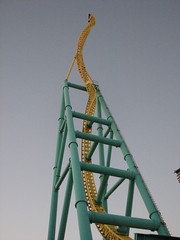 to create one or more pleasurable (or nauseous) sensations which are then sustained for as long as they can until they have to end the cycle. There’s no place for the thinking mind anywhere in this experience, no way to understand it that would help one to appreciate it better, at least not beyond finding ways to increase the immediate sensorial feedback. Not that there’s anything wrong with that, I love me a good flat ride whenever I go to the local carnival (the Zipper is always one of my favorites). I would even extend the argument for flat rides by pointing out how many styles of flat rides have a social value attached with them in the ways they allow people to share in the common experience and interact with each other while on the ride. However when visiting the amusement park smorgasbord that is Cedar Point, flat rides are for the most part the junk foods that are maybe nice to indulge in every once in a while but in the end you need something with actual culinary artistry to it rather than just the starches and saturated fats that appeal to the leftover hunter-gatherer parts of our genome. My concern is that Wicked Twister is better approximated by a can of Pringles than a dish of fine risotto.
to create one or more pleasurable (or nauseous) sensations which are then sustained for as long as they can until they have to end the cycle. There’s no place for the thinking mind anywhere in this experience, no way to understand it that would help one to appreciate it better, at least not beyond finding ways to increase the immediate sensorial feedback. Not that there’s anything wrong with that, I love me a good flat ride whenever I go to the local carnival (the Zipper is always one of my favorites). I would even extend the argument for flat rides by pointing out how many styles of flat rides have a social value attached with them in the ways they allow people to share in the common experience and interact with each other while on the ride. However when visiting the amusement park smorgasbord that is Cedar Point, flat rides are for the most part the junk foods that are maybe nice to indulge in every once in a while but in the end you need something with actual culinary artistry to it rather than just the starches and saturated fats that appeal to the leftover hunter-gatherer parts of our genome. My concern is that Wicked Twister is better approximated by a can of Pringles than a dish of fine risotto.
It’s not much of a concern. I still go on Wicked Twister whenever I can while I’m at Cedar Point, and for the most part I enjoy my rides. Sometimes the harness might knock me in the side of the head while entering one of the twists at full speed, but generally I try to brace for that. My mom avoids it like the plague, far too nausea inducing. Some people rate it as one of their favorites in the park, and I can’t for the life of me understand why. This is the coaster I always experience:
 After clearing the train the operator reads down “launching in three, two, one,” sometimes having fun with when the actual timing of the launch occurs. The movement forward is initially very sudden, jolting riders against the seat back as the train seems to instantaneously jump from standstill to its steady rate of acceleration, but that rate itself isn’t all too fast, seeming to reach the end of the launch strip just as a bit of real speed has been accumulated. The scream of the LIM motors along this stretch match almost exactly the screams of the riders. The train pulls up, pushing everyone back against their seats harder than the actual launch did, and the front catches a bit of a twist and sunshine, and then the rest of us fall back down. The acceleration kicks back in, not in a way that you can particularly feel it, but the sense of speed,
After clearing the train the operator reads down “launching in three, two, one,” sometimes having fun with when the actual timing of the launch occurs. The movement forward is initially very sudden, jolting riders against the seat back as the train seems to instantaneously jump from standstill to its steady rate of acceleration, but that rate itself isn’t all too fast, seeming to reach the end of the launch strip just as a bit of real speed has been accumulated. The scream of the LIM motors along this stretch match almost exactly the screams of the riders. The train pulls up, pushing everyone back against their seats harder than the actual launch did, and the front catches a bit of a twist and sunshine, and then the rest of us fall back down. The acceleration kicks back in, not in a way that you can particularly feel it, but the sense of speed, especially as the train flies back through the station at the end of this stretch, is much stronger. Once again we angle up although this time we’re pushed forward against the restraints, the train making it much farther up this back tower than it did the front (although from an individual’s perspective this will vary greatly; back seat riders will notice a huge difference while front seat riders will think the ride’s becoming weaker).
especially as the train flies back through the station at the end of this stretch, is much stronger. Once again we angle up although this time we’re pushed forward against the restraints, the train making it much farther up this back tower than it did the front (although from an individual’s perspective this will vary greatly; back seat riders will notice a huge difference while front seat riders will think the ride’s becoming weaker).
Once again the train is pushed forward down the launch track, the acceleration again not too strong but the speed really having been built up to near maximum, about 69 mph.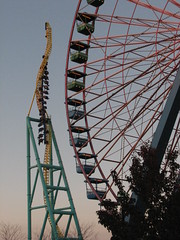 The train very quickly angles upward in about half the time it took the first time to become vertical, and the front twists around all the way up to the top. For the most part one can only distinctly feel lateral forces, but notice something odd: the forces are both stronger and opposite on your head and feet. That’s pure rotational forces, something Wicked Twister is probably one of the best in the world at doing. The negative side-effect is that you’re going to have a hard time noticing (or at least enjoying) any airtime, not that that’s a huge drawback for me. Once again the train spirals back down, this time taking much longer to get back to the pullout, but once we’re back at beach-level the time before we’re shooting up the back tower again is incredibly short. The LIM motors add a few extra miles per hour on this final segment until the train is rushing back through the station at 72 mph, and this second rear spike ascension is easily the most intense of all, not just because of the extra speed and height but because one is forces forward into their harness and cannot see where they’re going at all.
The train very quickly angles upward in about half the time it took the first time to become vertical, and the front twists around all the way up to the top. For the most part one can only distinctly feel lateral forces, but notice something odd: the forces are both stronger and opposite on your head and feet. That’s pure rotational forces, something Wicked Twister is probably one of the best in the world at doing. The negative side-effect is that you’re going to have a hard time noticing (or at least enjoying) any airtime, not that that’s a huge drawback for me. Once again the train spirals back down, this time taking much longer to get back to the pullout, but once we’re back at beach-level the time before we’re shooting up the back tower again is incredibly short. The LIM motors add a few extra miles per hour on this final segment until the train is rushing back through the station at 72 mph, and this second rear spike ascension is easily the most intense of all, not just because of the extra speed and height but because one is forces forward into their harness and cannot see where they’re going at all.
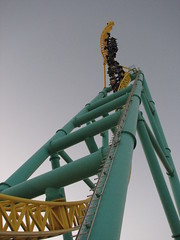 After this the ride has maxed out its potential and the LIMs grab the train a little bit before sending it up the forward tower for the third and last time. We reach higher than the first time up but the ride’s as good as over when you compare it to the previous two tower ascents. Back down, the final brakes grab hard, pushing everyone back against their seats. This braking force, perhaps because it’s coupled with the reduced bloodflow to the brain after forty seconds of ride time, for some reason always leaves me feeling a little dizzy and lightheaded for a moment, as if I want to go to sleep (sometimes I even put my head against the restraint and close my eyes for a moment as the magnets slowly grind the train back to the loading platform), although I imagine if I were more of a drug-user I might have a better analogy for this sensation.
After this the ride has maxed out its potential and the LIMs grab the train a little bit before sending it up the forward tower for the third and last time. We reach higher than the first time up but the ride’s as good as over when you compare it to the previous two tower ascents. Back down, the final brakes grab hard, pushing everyone back against their seats. This braking force, perhaps because it’s coupled with the reduced bloodflow to the brain after forty seconds of ride time, for some reason always leaves me feeling a little dizzy and lightheaded for a moment, as if I want to go to sleep (sometimes I even put my head against the restraint and close my eyes for a moment as the magnets slowly grind the train back to the loading platform), although I imagine if I were more of a drug-user I might have a better analogy for this sensation.
The final question I’ll pose my readers with is: are Wicked Twister’s successes attributable to the roller coaster design despite the heavy flat-ride influences, or is there something more?
In terms of the actual sensations produced it’s easily one of the most out-there ride experiences you can find (as evidenced by my body’s reaction when we finish with the final deceleration strip), and looking at it more closely I now realize that my initial appraisal of the coaster as not much more than an amped-up flat ride experience is completely wrong. It never approaches a tower with the same speed it did on a previous cycle, and each time it’s only faster and more intense, at least until the final one. There, we’ve got a progression that continually builds up to a climax just with that. But additionally, as a result of the increased speed it also affects the timing of the elements so it’s not just simple repetition. The first cycles will spend much more time on the launch track and curving around the pull-ups than on the actual towers. As the ride gains more speed, the time spent on the launch track and pull-ups decreases quite significantly, while the time spent on the towers increases, along with the total rotation achieved. If there is repetition in this ride, it’s hardly anything like what one would get on a flat ride, and as I’ve noted in other reviews, while basic repetition is generally bad, repetition with variation can be a far more powerful sequencing structure than if each and every moment is completely unique from the other.
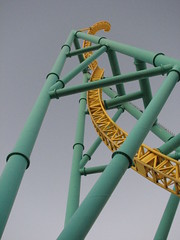 One more thing I want to mention is the seating. I remember once a while ago I was in line behind an enthusiast who commented to me just before finding a seat that it doesn’t really matter where you ride on this one. I think he was referring just to the total quantity of airtime produced, which I suppose makes a bit of sense because the more height one achieves by sitting farther forward or back in the train on one tower will only be canceled out when you go up the reverse tower. But it was still completely strange to hear, Wicked Twister probably is the one coaster I could think of where the most difference is found between different seats, to the point that you almost get completely unique ride experiences. While the front tower will get three circuits compared to the back’s two, I generally find myself preferring the back because the experience of going up the tower backward is so radical, and as I mentioned, both the first and last trips up the forward spike are relatively toothless. That said, the very front row is always a treat when the line isn’t too long, looking up the forward spike and watching the perfectly heartlined track seem to spiral away until there’s only fifteen feet or so of yellow rails left is always a one-of-a-kind experience. However, the best seat hands-down
One more thing I want to mention is the seating. I remember once a while ago I was in line behind an enthusiast who commented to me just before finding a seat that it doesn’t really matter where you ride on this one. I think he was referring just to the total quantity of airtime produced, which I suppose makes a bit of sense because the more height one achieves by sitting farther forward or back in the train on one tower will only be canceled out when you go up the reverse tower. But it was still completely strange to hear, Wicked Twister probably is the one coaster I could think of where the most difference is found between different seats, to the point that you almost get completely unique ride experiences. While the front tower will get three circuits compared to the back’s two, I generally find myself preferring the back because the experience of going up the tower backward is so radical, and as I mentioned, both the first and last trips up the forward spike are relatively toothless. That said, the very front row is always a treat when the line isn’t too long, looking up the forward spike and watching the perfectly heartlined track seem to spiral away until there’s only fifteen feet or so of yellow rails left is always a one-of-a-kind experience. However, the best seat hands-down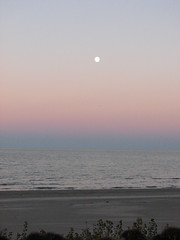 goes to the right side seat in second-to-last row of the train, at night. Why not the very last row? Because as the train ascends the backward spike, this seat will twist outward from around the cars ahead of it leaving nothing in front of you except for the sandy beach 200ft below. Unable to see how close we are to derailment at the top of the tower (‘it’s gotta be pretty damn close’, my mind always screams at me), this experience probably even betters Top Thrill Dragster in terms of pure scare factor.
goes to the right side seat in second-to-last row of the train, at night. Why not the very last row? Because as the train ascends the backward spike, this seat will twist outward from around the cars ahead of it leaving nothing in front of you except for the sandy beach 200ft below. Unable to see how close we are to derailment at the top of the tower (‘it’s gotta be pretty damn close’, my mind always screams at me), this experience probably even betters Top Thrill Dragster in terms of pure scare factor.
One last completely random, unrelated thought before I close this out: what the heck ever happened to the wheel coverings? I can’t even remember when they were removed, it’s been so long that the wheel assemblies have been operating naked I even began to think that they were always like that until I noticed some pictures of them just now from the ride’s opening year with these big magenta globs covering up the wheels. Also, this is a quote from my dad from a couple years ago; “maybe it’s just me but I’ve always thought that the voice for the pre-recorded announcement in the station sounds very sexy”.
Okay, that’s all.
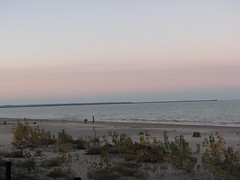 [1] Technically it’s tied for third fastest with the also 72 mph Magnum XL-200, and whether the 215ft. towers on Wicked Twister should count above Magnum’s 205ft crest even though riders themselves never reach that pinnacle will probably remain debatable. I also could have sworn that Maverick was originally advertised as having a 72 mph top speed but now the RCDb is telling me it’s an even 70.
[1] Technically it’s tied for third fastest with the also 72 mph Magnum XL-200, and whether the 215ft. towers on Wicked Twister should count above Magnum’s 205ft crest even though riders themselves never reach that pinnacle will probably remain debatable. I also could have sworn that Maverick was originally advertised as having a 72 mph top speed but now the RCDb is telling me it’s an even 70.
[2] King’s Island’s Tomb Raider: The Ride was one such exception, as least as it had been in its original form. There are probably other examples of these ‘theatrical’ flat rides out there, but it’s not really important because the theatrical elements are more or less independent of what the flat ride experience at its core is.
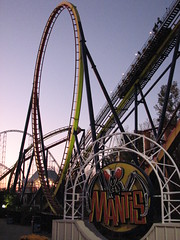
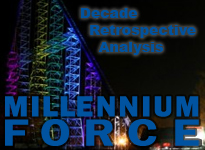


Great analyses! If Mantis was named Banshee as originally planned I would like the ride more. I’m not sure why. Perhaps it just sounds more reckless and fitting rather than the static “Mantis”. That aside, I would sit working MF’s entrance an watch Mantis and I’m convinced there is something about the layout that is screaming for backwards floorless trains. I imagine a weightless drop, free flying leg flipping grand sized inversions, suspense and nervous anticipation through the unique middle elements and reckless abandon after the MCBR. All with your ankles lost in the wind. CP must do this. But people do still line up and queue for over an hour for the thing as it is. It’s O.K. It ripped my watch off my wrist on a ride night… I’m not sure how but it did seem to do it angrily. I agree that the end of the ride over dirt kinda sucks. But you highlighted it’s strengths very nicely.
Wicked Twister: I will have to try your recommended seat. That sounds right. So far I have had only one ride towards the back and I could only compare it to the experience of being grabbed vertically and stopped by a holding brake and I liked that much better than WT’s back spiral. But I will try again.
Thanks!
I’m glad you’ve highlighted Mantis’ final section as the part that makes it stand out among B&M’s large stand-up coasters. The quick banking transitions caught me by surprise when I rode Mantis over a decade ago, and they are probably the only moments that I clearly remember as I think back on my ride experience today. I think even the most devoted “B&M fanboys” (of which I would consider myself part) are a little frustrated with the lack of freshness and originality in many of their models, so it’s nice when a ride like Mantis demonstrates their occasional ability to incorporate surprise and vitality into one of their creations.
You know, despite my occasional feeling that you probably secretly enjoy trashing rides that the masses deem great (and I say this jokingly, of course), and despite the sometimes cumbersome complexity of your reviews, I must say that I love your site! There’s something irresistible about the thoroughness of your analyses that leaves me clicking on review after review. I appreciate that you do a great job of clarifying your meaning as you write your honest impressions, and you genuinely seem interested in identifying a ride’s strengths and weaknesses rather than blaring out generalizations and biased statements. Although I feel very differently about certain rides you describe, I often enjoy the mere deconstruction of your thoughts and experiences. Good work!
Thank you for the feedback! I agree with your assessment that a lot of my reviews have a latent motive to appear revisionary if not completely contradictory to popular opinion, and that they occasionally get needlessly wordy and complex. I think that was much more so present in the earlier stuff from 2009 when I first started writing, as I felt I needed a lot more to prove. If I were to assemble a portfolio of my best work so far, it would probably mostly be from the European series, and I hope that to change again when I complete the California and Asian articles. I’m always looking over my work and figuring out how I can do better or do differently on the next review, that is whenever I’m not cringing over the sophomoric amateurishness of some of them. It’s good to hear from others how my writing is read and interpreted, so thank you again for taking the time to leave me some feedback.
I am always surprised that Mantis’ finale doesn’t garner more attention from enthusiasts, as the more I ride other B&M coasters the more I realize just how lucky Cedar Point got with both Raptor and Mantis, at least in regards to having strong finishes. I think regardless of what side of the fence you’re on in regards to B&M’s craftsmanship, when you look at the layout for, say, Leviathan, you can’t deny that they’re simply inept at plotting rides with a strong (even any!) dramatic arc to them. For whatever it’s faults, Mantis is still easily one of the first coasters I’d refer people to whom are looking for a B&M with good layout sequencing.
^ What can I say? Your statement about B&M’s area of ineptitude can be applied to so many of their models, especially those of the last decade. It’s for this reason that I’m very curious as to the ride experience is on Georgia Scorcher. Based on the on-ride POV videos I’ve seen of it, Scorcher appears to capture some of the intense directional fluctuations that make Mantis’ finale so cool, and because of its compact footprint, it doesn’t waste time with the compulsory “intro inversions”. I wouldn’t be surprised if I liked it much more than the two biggest stand-ups.
Anyway, I’ll be sure to check out your reviews of more of the European parks, as well as any material you post at a later date! (Heck, I’ll probably end up enjoying your “cringe-worthy” reviews, too. Despite my knee-jerk reaction to the very first review I came across, I really do find your nuanced approach to coaster reviews a fresh change of pace!)
I rode Georgia Scorcher once back in 2003. I recall liking it back then, but I can’t really give any more specific reaction to it. Your assessment sounds about right, and I think I would rate it, Mantis and the sadly on it’s way out Iron Wolf as the best B&M stand-up coasters. A shame two of those three have a reputation for being extremely rough and unforgiving. I don’t think Iron Wolf will survive that list when it relocates to Six Flags America, since most of what made it so successful to me was how dense the foliage had grown around what had been a compact layout. Hopefully they’ll fix the chronic roughness issues and will give it a new audience.